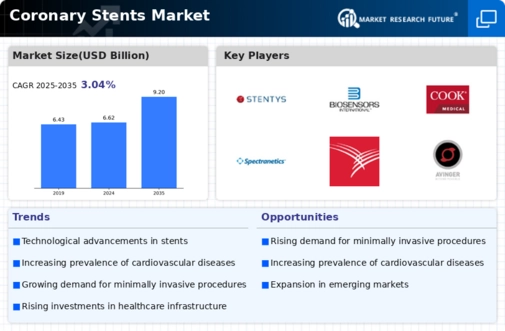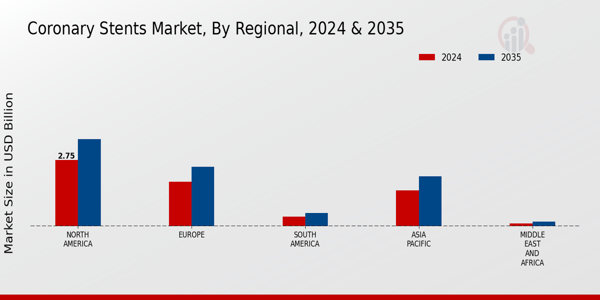Rising Geriatric Population
The increasing geriatric population is a significant factor influencing the Coronary Stents Market. As individuals age, the risk of developing cardiovascular diseases escalates, leading to a higher demand for coronary interventions. The World Health Organization projects that the number of people aged 60 years and older will double by 2050, indicating a growing patient base for stenting procedures. This demographic shift necessitates the availability of effective treatment options, thereby driving the market for coronary stents. Additionally, healthcare systems are adapting to cater to the needs of older patients, which may include more frequent use of stents in clinical practice. Consequently, the Coronary Stents Market is likely to expand in response to this demographic trend.
Government Initiatives and Funding
Government initiatives aimed at improving cardiovascular health are playing a crucial role in the Coronary Stents Market. Many countries are implementing policies to enhance access to cardiovascular care, including funding for advanced medical technologies. These initiatives often focus on reducing healthcare costs associated with cardiovascular diseases, which can be substantial. By promoting the use of coronary stents as a cost-effective treatment option, governments are likely to stimulate market growth. Furthermore, public health campaigns aimed at raising awareness about heart health may lead to increased screening and early intervention, further driving demand for coronary stents. As a result, the Coronary Stents Market stands to benefit from supportive governmental policies and funding.
Technological Innovations in Stent Design
Technological advancements in stent design and materials are transforming the Coronary Stents Market. Innovations such as bioresorbable stents and drug-eluting stents are gaining traction due to their ability to reduce complications and improve patient outcomes. These advancements not only enhance the efficacy of stenting procedures but also address concerns related to long-term stent placement. The introduction of new materials that promote better biocompatibility and reduce restenosis rates is likely to attract more healthcare providers to adopt these technologies. As a result, the Coronary Stents Market is poised for growth, with manufacturers investing in research and development to create next-generation stents that meet evolving clinical needs.
Increasing Prevalence of Cardiovascular Diseases
The rising incidence of cardiovascular diseases is a primary driver for the Coronary Stents Market. As populations age and lifestyle-related health issues become more prevalent, the demand for effective treatment options escalates. According to recent data, cardiovascular diseases account for a substantial percentage of global mortality rates, prompting healthcare systems to prioritize interventions. This trend is likely to fuel the adoption of coronary stents, as they are essential in treating blocked arteries. The Coronary Stents Market is expected to witness significant growth as healthcare providers seek to enhance patient outcomes through advanced stenting technologies. Furthermore, the increasing awareness of heart health among the general population may lead to earlier diagnoses and interventions, further propelling market expansion.
Growing Preference for Minimally Invasive Procedures
The growing preference for minimally invasive procedures is significantly impacting the Coronary Stents Market. Patients increasingly favor treatments that offer quicker recovery times and reduced hospital stays. Coronary stenting, as a minimally invasive option, aligns with this trend, providing effective solutions for coronary artery disease without the need for extensive surgical interventions. The rise in patient awareness regarding the benefits of such procedures is likely to drive demand for coronary stents. Additionally, healthcare providers are adopting these techniques to enhance patient satisfaction and outcomes. As a result, the Coronary Stents Market is expected to experience robust growth, driven by the shift towards less invasive treatment modalities.


















Leave a Comment